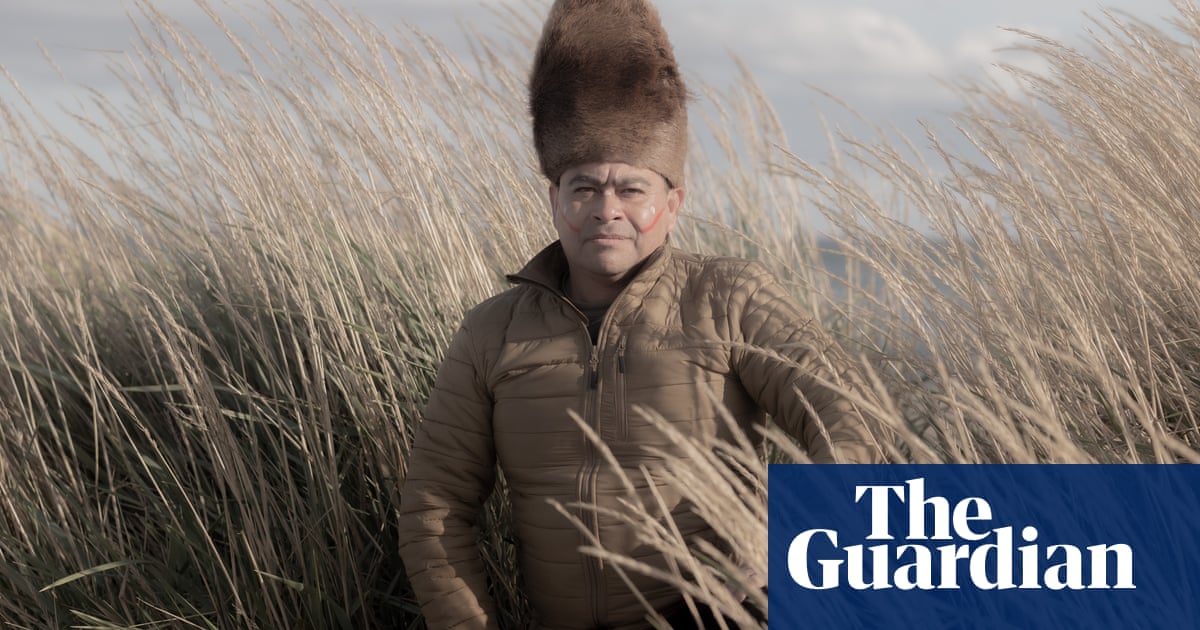
When José Luis Vásquez Chogue travelled from Santiago to see his ancestral land in Tierra del Fuego for the first time in October 2020, he cried like never before. For thousands of years, his people, the Selk’nam, lived in the extreme south of the American continent, the most southerly occupied part of the globe. Tierra del Fuego was their home until they were persecuted, tortured and slain by invading farmers, who rewarded anyone who killed a Selk’nam. About 5,000 Indigenous people were murdered in less than 50 years, with 100 survivors remaining, estimates indicate.
For the Selk’nam, the 19th century in Chile was a time of terror, though one hears little about it. Until three weeks ago, the government officially ignored the story and the destiny of this people. Not any more. On 5 September, by 117 votes in favour and one abstention, the National Congress finally recognised the Selk’nam as one of the 11 original peoples of Chile.
Although late, the decision removes from limbo the 1,144 people who declared themselves to be of Selk’nam ethnicity in the last Chilean census in 2017. Many have stories similar to Chogue’s. He lived until the age of 10 with his grandfather, a man adopted as a child by a family of French origin, and who hid his Indigenous roots his entire life for fear of being murdered.
“One of the most important things about this decision is no longer saying we are dead. We are alive and do not need to prove it any more,” says Chogue, a leader of the Selk’nam in Chile. “I am not a ‘descendant’. I am Selk’nam, just like my mother, my grandfather.”
According to the report from the Commission for Historical Truth and the New Agreement, “between the last decades of the 19th century and the first decades of the 20th century, the Chilean state policy of concessions and the introduction of sheep farming produced a veritable genocide of Selk’nam families,” whose ancestral territory comprised the entire island of Tierra del Fuego.
“I always felt as if I was missing something. There was a hole inside me,” says Chogue, remembering the day he set foot on his land. “At that moment, I understood what was missing in my life: walking in my land, the land of my ancestors.”
As part of the official recognition of the Selk’nam, members of parliament regretted the role Chilean and Argentinean states played in serial massacres against Indigenous people.
“We were hunter-gatherers who lived in harmony with nature until European farmers and sheep breeders arrived,” says Chogue about the origins of the genocide.
The land dispute is crucial to understanding how a people reach the brink of extermination. It all started with the invasion of land being legalised by the government. European farmers and sheep breeders arrived with the support of the state and gained possession of lands once inhabited by the Selk’nam. When the farmers appropriated the land, the Selk’nam hunted their sheep, incurring resentment among the settlers.
After gaining official recognition, Selk’nam people, scattered all over Chile, celebrated. However, they do not yet know what historical reparations will involve. In Argentina, Selk’nam gained recognition in 1995. And the Mapuche in Chile, for example, had part of their land returned to them. Whatever comes next, the difference is that, from now on, the Selk’nam will be heard as a people.
Dawson Island in Tierra del Fuego was the last place that listed the Selk’nam alive before their erasure from the record books. Carmelo Chogue, José’s grandfather, lived on Dawson Island until the Catholic church took him and gave him up for adoption. José and his grandfather never talked about Selk’nam life.
“He got used to not talking to survive. He simply didn’t talk about who he was,” says Chogue, who gets emotional imagining everything his grandfather suffered trying to hide his past.
In Santiago, Selk’nam representative Hema’ny Molina says she is grateful that “the chamber of deputies has accepted our people as a living community of Chile. I know this is just the beginning, and there is much work ahead. But we have finally completed the most important stage for integration into the law.”
Molina, as president of the Covadonga Ona Selk’nam community, led the four-year process towards official recognition. “Now a phase is coming where, at least, legality is with us,” she says.
“We are no longer extinct in this country. We can safely say we are Selk’nam without recriminations, or anyone expelling us, or denying us representation. I am grateful to my ancestors, my family, and so many people who supported us along the way, and I am happy to bring this good news to Tierra del Fuego.”
More than 500 years ago, the Portuguese navigator Ferdinand Magellan discovered a sea passage in the south of the planet while leading an expedition from the Kingdom of Spain. It was a region unknown to Europeans, who called it Terra Australis Incognita – the unknown southern land. To its Indigenous inhabitants, that land was called Karukinka (our land).
After Magellan, and long before Tierra del Fuego was divided between Argentina and Chile in a treaty signed in 1881, several adventurers tried to occupy Karukinka. First, they were looking for gold. They brought germs that caused epidemics of tuberculosis, syphilis and respiratory infections – the same biological weapons that hit and decimated other Indigenous peoples of the Americas.
Then came the mass arrival of European, Chilean and Argentinian farmers who saw Karukinka as the perfect place to raise sheep to produce wool and meat. They seized the territory between Patagonia and Tierra del Fuego inhabited by the Indigenous groups.
Coexistence between farmers and hunter-gatherers proved impossible. The newcomers hired bounty hunters to eradicate the Selk’nam population and seize the land. They would cut off the ears of Selk’nam caught hunting sheep and take them to the farmers as proof of a “job done” to receive payment. Selk’nam repeat offenders would have their heads cut off. In retaliation, the Selk’nam killed farmers and bounty hunters with their arrows.
But it was an unbalanced conflict, and soon the Selk’nam men were exterminated. Elderly people, women and children were captured and sold as domestic servants or sent to Salesian missions in Rio Grande, on the Argentinian side of Terra del Fuego, or Dawson Island, on the Chilean side, to be “civilised”. Women were repeatedly raped and forced to marry non-natives. Diseases, malnutrition, evangelisation, loss of culture and separation from families decimated the population. Only young children remained.
A century passed – much of it under a series of military dictatorships – with the Selk’nam genocide not being addressed. That began to change only recently, in the 2010s, due to social media groups, where users looking for their origins found one another. Now, together, the Selk’nam face the process of rewriting official history, decolonising and denormalising the historical perspective, and recovering and reframing what happened. They have created community centres where families’ experiences, stories and memories are shared and the truth is confronted.
Miguel Pantoja is a member of the Rafaela Ishton Indiginous Selk’nam community in Argentina, living in the Rio Grande, on Tierra del Fuego’s Isla Grande. Like Chogue, he does not accept the label of “descendants”. He says: “Having to explain myself, to think myself, is something violent.”
Molina agrees: “I always knew I was Selk’nam, but that didn’t mean living as such or understanding how to do it. There are several complex layers. For many years, we were unaware of other families’ existence. It was a feeling of emptiness and total loneliness. Who am I going to talk to? Who am I going to tell? Will people believe me?”
Over the past decade, many Selk’nam have undertaken emotional and physical journeys to learn and recognise the history of their ancestors. It is not an easy path, says Molina: “Our first glimpse as Selk’nam is always painful because what is told in history books is not the history we know. Most of us go through a spiritual quest to fill the void, the feeling of not fitting in, of belonging nowhere, until we find our culture. The answers are there, even though we are not in Tierra del Fuego.”
The genocide deeply marked the few Selk’nam who remained in Patagonia. Survivors raised their children without emphasising their ethnicity. That was the case of Pantoja’s great-grandmother. “To protect subsequent generations, the elders did not transmit our language. That’s why I don’t speak the Selk’nam language,” he says.
Even today, the inhabitants of Isla Grande do not assume the Selk’nam ancestry. “The stigma of death was so strong that the Selk’nam did not want to be Indigenous. So they raised their children with non-Indigenous criteria,” says Molina.
Going forward, Molina is interested in the truth, away from romanticised notions of Selk’nam. She says: “People want to see us as [we were] before, but we have grown, like everyone else. We have mobile phones, computers, jobs, we pay taxes, we stick to work hours.”
Pantoja reinforces the need for people to abandon racial stereotypes. “Despite everything, we have not died. But we have changed. We are alive, and we are here, right here.”
Marcio Pimenta is an explorer, photographer and writer. Nina Radovic Fanta is a cultural anthropologist and lives in Patagonia. Caio Barretto Briso is a reporter and screenwriter based in Rio de Janeiro.












